Austrian actress Maria Perschy (1938-2004) was the sexy leading lady of many European films of the late 1950s before she made a short career in Hollywood in films by John Huston and Howard Hawks. In the 1970s she appeared in Spanish and Italian low-budget horror films and became a cult figure.
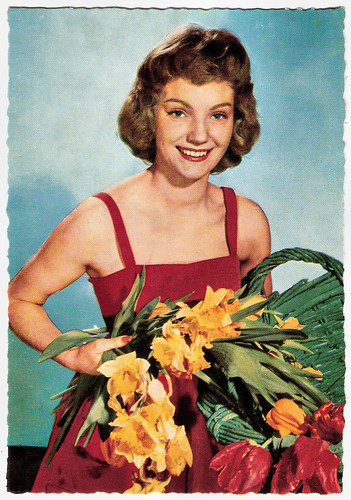
German postcard by WS-Druck, Wanne-Eickel, no. F 99. Photo: Klaus Collignon.
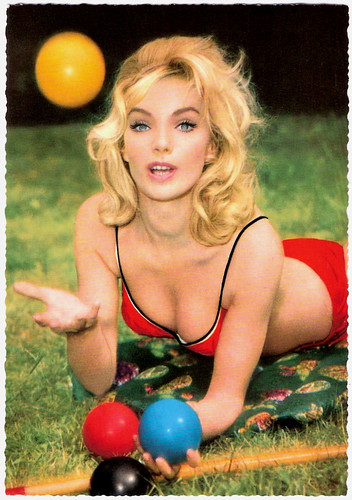
German postcard by Krüger, no. 902/376. Photo: Lothar Winkler.
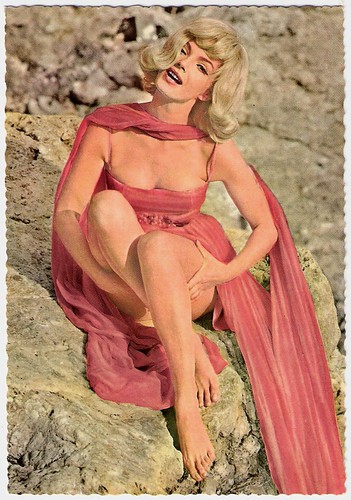
German postcard by Krüger, no. 902/403. Photo: Lothar Winkler.
Herta-Maria Perschy was born in 1938 in Eisenstadt, Austria in 1938. She moved to Vienna at the age of 17 to study acting at the prestigious Max Reinhardt Seminar. There she was awarded with the Kunstförderungspreis für Darstellende Kunst der Stadt Wien, an award of the city of Vienna to stimulate young and talented actors.
During her studies, the gorgeous and appealing brunette knockout made her film début with a small role in Roter Mohn/Red Poppy (Franz Antel, 1956) starring Joachim Fuchsberger. After finishing her studies, her teacher Susi Nicoletti helped to get her a contract at the Bavaria Filmstudios in Germany.
Her first major success came with Nasser Asphalt/Wet Asphalt (Frank Wisbar, 1958). In this Film Noir about the dangers of tabloid reporting, she starred opposite the young Horst Buchholz.
Soon this success was followed by films like Der Schwarze Blitz/The Black Lightning (Hans Grimm, 1958) with former ski champion Toni Sailer, Die Landärztin vom Tegernsee/Lady Country Doctor (Paul May, 1958), with Marianne Koch, Natürlich die Autofahrer/Of Course the Drivers (Erich Engels, 1959) with comedian Heinz Erhardt, and Der Held meiner Träume/The Hero of My Dreams (Arthur Maria Rabenalt, 1960) with Carlos Thompson.
Another commercial success was the clichéd drama Lebensborn/Fountain of Life (Werner Klingler, 1960), loosely based on the super-race propagation plan by Nazi Heinrich Himmler, which recruited men and women for their fair skin, blond hair, and blue eyes alone. These specially selected Aryans were ordered to breed, for the Fatherland.
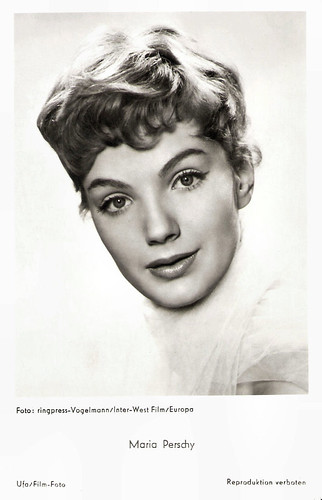
German postcard by Ufa, Berlin-Tempelhof, no. FK 3984. Photo: Ringpress / Vogelmann / Inter-West Film / Europa.
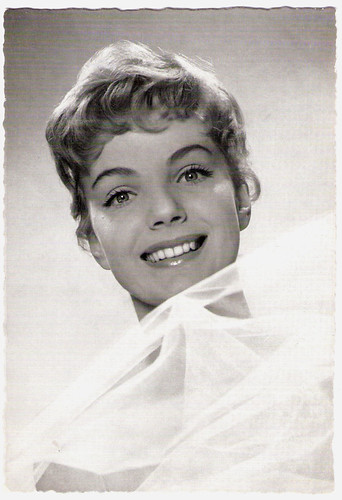
German postcard by WS-Druck, Wanne-Eickel, no. 287. Photo: Europa / Ringpress / Vogelmann.
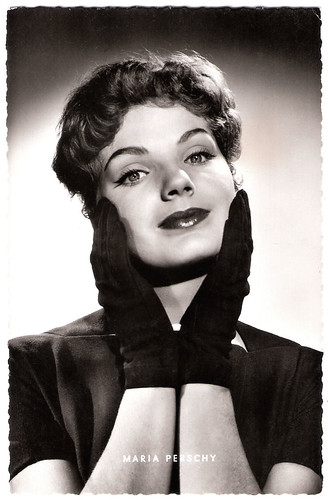
German postcard by Kunst und Bild, Berlin-Charlottenburg, no. A 1546.
Her acting career would eventually take Maria Perschy to France, Italy, Great Britain and Hollywood. Among her European films were Il Moralista/The Moralist (Giorgio Bianchi, 1959), I Piaceri del sabato notte/Call-Girls (Daniele D'Anza, 1960) with Pierre Brice, Un Amore a Roma/Love In Rome (Dino Risi, 1960) with Mylène Demongeot, and The Password Is Courage (Andrew L. Stone, 1962) starring Dirk Bogarde.
Hal Erickson writes at AllMovie about her short Hollywood career: "Like many attractive European actresses, Perschy tended to be shunted into sexpot roles in her English-language films: her character name in Howard Hawks' Man's Favorite Sport (1964), for example, was 'Easy.' By far, her best non-European film assignment was the part of Magda in John Huston's Freud (1962)."
In this biopic the pioneering psychotherapist himself was played by Montgomery Clift, while Rock Hudson was her leading man in the comedy Man's Favorite Sport? She also appeared with Cliff Robertson in the routine war film Squadron 633 (Walter Grauman, 1964) and the South-African adventure African Gold (David Millin, 1965).
Perschy lived in Spain. She played in Hollywood and in European productions, both films and TV-series. In Germany she appeared in the Edgar Wallace Krimi Der Henker von London/The Mad Executioners (Edwin Zbonek, 1963) with Hansjörg Felmy, as partner of Horst Frank in the Thriller Weiße Fracht für Hongkong/Mystery of the Red Jungle (Helmut Ashley, Giorgio Stegani, 1964) and in the Sci-Fi adventure Der Chef wünscht keine Zeugen/No Survivors, Please (Hans Albin, Peter Berneis, 1964).
Later followed adventure films and Westerns like Die Banditen vom Rio Grande/The Bandits of the Rio Grande (Helmuth M. Backhaus, 1965) with Harald Leipnitz, Kommissar X – Jagd auf Unbekannt/Kiss Kiss, Kill Kill (Gianfranco Parolini, 1966), Mister Dynamit – morgen küsst Euch der Tod/Die Slowly, You'll Enjoy It More (Franz Josef Gottlieb, 1967) with Lex Barker, and The Castle of Fu Manchu (Jesus Franco, 1969), featuring Christopher Lee.
Her last big film success in Germany was the comedy Dr. med. Fabian – Lachen ist die beste Medizin/Dr. Fabian: Laughing Is the Best Medicine (Harald Reinl, 1969) in which she starred opposite Hans-Joachim Kulenkampff.
In those years she had longtime relationships with actor Joachim Hansen – her co-star of Lebensborn - and later with skier Roger Staub.
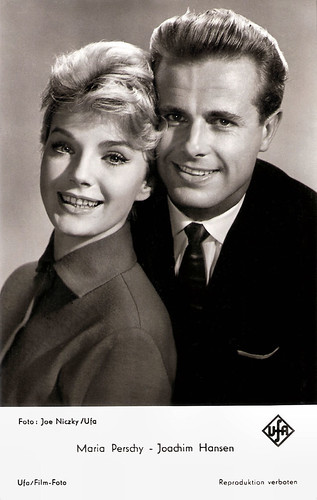
German postcard by Ufa, Berlin-Tempelhof, no. FK-4797. Photo: Joe Niczky / Ufa. Publicity still for Lebensborn/Ordered to Love (Werner Klingler, 1961) with Joachim Hansen.
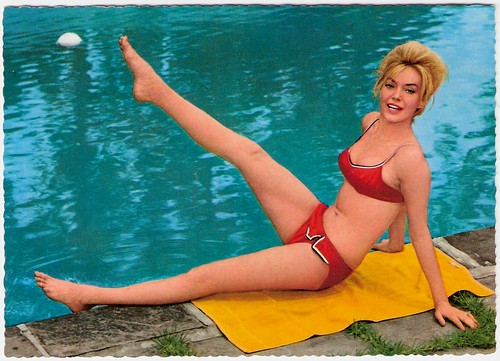
German postcard by Krüger, no. 902/373. Photo: Bernard of Hollywood.
While shooting in Spain in 1971, Maria Perschy's face was burned severely by an accidental fire which required several operations. She was bedridden for an extended period before she could resume her career.
In Italy and Spain she appeared in many low-grade horror films, including El Buque Maldito/Ghost Galleon (Amando De Ossorio, 1974) and the Spanish rip-off of The Exorcist, Exorcismo (Paul Naschy aka Jacinto Molina, 1964). These films made her a kind of cult figure.
In 1976 the Spanish state pressed her to get a Spanish passport, Perschy choose to return to her native Austria. She did not stay long though. From 1977 on she lived in Los Angeles and was married to a writer.
By then her career in America petered out. She only appeared on TV in the daytime soap General Hospital (1977) and as a guest star in Hawaii Five-O (1978), a detective series starring Jack Lord as the head of a special state police unit answering only to the Governor of Hawaii.
For a while she worked as a translator and she also worked in the antique retail. Her husband committed suicide in 1983 and she returned again to Austria in 1985.
She performed in stage plays such as A. R. Curney's Love Letters and the mystery play Witness for the Prosecution by Agatha Christie in Austria, Germany and Switzerland. She continued to play in TV series like the popular Krimi Tatort (1998) and Rosamunde Pilcher (1998).
Her last feature films were the low-budget shocker Vultures (Paul Leder, 1983) starring Stuart Whitman, and the romantic comedy Eine Frau namens Harry/Harry and Harriet (Cyril Frankel, 1990).
In 2004 Maria Perschy died of cancer in Vienna. She was 66. She had been married twice and had one daughter.
American trailer for Lebensborn/Ordered to Love (1961). Source: Video Detective (YouTube).
Trailer for Squadron 633(1964). Source: Michael Appert (YouTube).
Trailer Freud (1962). Source: Cliff Held (YouTube).
El buque maldito/Ghost Galleon (1974). Source: 2ombieboy (YouTube).
Sources: Stephanie d’Heil (Steffi-line), Hal Erickson (AllMovie), Wikipedia and IMDb.

German postcard by WS-Druck, Wanne-Eickel, no. F 99. Photo: Klaus Collignon.

German postcard by Krüger, no. 902/376. Photo: Lothar Winkler.

German postcard by Krüger, no. 902/403. Photo: Lothar Winkler.
Breeding for the Fatherland
Herta-Maria Perschy was born in 1938 in Eisenstadt, Austria in 1938. She moved to Vienna at the age of 17 to study acting at the prestigious Max Reinhardt Seminar. There she was awarded with the Kunstförderungspreis für Darstellende Kunst der Stadt Wien, an award of the city of Vienna to stimulate young and talented actors.
During her studies, the gorgeous and appealing brunette knockout made her film début with a small role in Roter Mohn/Red Poppy (Franz Antel, 1956) starring Joachim Fuchsberger. After finishing her studies, her teacher Susi Nicoletti helped to get her a contract at the Bavaria Filmstudios in Germany.
Her first major success came with Nasser Asphalt/Wet Asphalt (Frank Wisbar, 1958). In this Film Noir about the dangers of tabloid reporting, she starred opposite the young Horst Buchholz.
Soon this success was followed by films like Der Schwarze Blitz/The Black Lightning (Hans Grimm, 1958) with former ski champion Toni Sailer, Die Landärztin vom Tegernsee/Lady Country Doctor (Paul May, 1958), with Marianne Koch, Natürlich die Autofahrer/Of Course the Drivers (Erich Engels, 1959) with comedian Heinz Erhardt, and Der Held meiner Träume/The Hero of My Dreams (Arthur Maria Rabenalt, 1960) with Carlos Thompson.
Another commercial success was the clichéd drama Lebensborn/Fountain of Life (Werner Klingler, 1960), loosely based on the super-race propagation plan by Nazi Heinrich Himmler, which recruited men and women for their fair skin, blond hair, and blue eyes alone. These specially selected Aryans were ordered to breed, for the Fatherland.

German postcard by Ufa, Berlin-Tempelhof, no. FK 3984. Photo: Ringpress / Vogelmann / Inter-West Film / Europa.

German postcard by WS-Druck, Wanne-Eickel, no. 287. Photo: Europa / Ringpress / Vogelmann.

German postcard by Kunst und Bild, Berlin-Charlottenburg, no. A 1546.
Kiss Kiss, Kill Kill
Her acting career would eventually take Maria Perschy to France, Italy, Great Britain and Hollywood. Among her European films were Il Moralista/The Moralist (Giorgio Bianchi, 1959), I Piaceri del sabato notte/Call-Girls (Daniele D'Anza, 1960) with Pierre Brice, Un Amore a Roma/Love In Rome (Dino Risi, 1960) with Mylène Demongeot, and The Password Is Courage (Andrew L. Stone, 1962) starring Dirk Bogarde.
Hal Erickson writes at AllMovie about her short Hollywood career: "Like many attractive European actresses, Perschy tended to be shunted into sexpot roles in her English-language films: her character name in Howard Hawks' Man's Favorite Sport (1964), for example, was 'Easy.' By far, her best non-European film assignment was the part of Magda in John Huston's Freud (1962)."
In this biopic the pioneering psychotherapist himself was played by Montgomery Clift, while Rock Hudson was her leading man in the comedy Man's Favorite Sport? She also appeared with Cliff Robertson in the routine war film Squadron 633 (Walter Grauman, 1964) and the South-African adventure African Gold (David Millin, 1965).
Perschy lived in Spain. She played in Hollywood and in European productions, both films and TV-series. In Germany she appeared in the Edgar Wallace Krimi Der Henker von London/The Mad Executioners (Edwin Zbonek, 1963) with Hansjörg Felmy, as partner of Horst Frank in the Thriller Weiße Fracht für Hongkong/Mystery of the Red Jungle (Helmut Ashley, Giorgio Stegani, 1964) and in the Sci-Fi adventure Der Chef wünscht keine Zeugen/No Survivors, Please (Hans Albin, Peter Berneis, 1964).
Later followed adventure films and Westerns like Die Banditen vom Rio Grande/The Bandits of the Rio Grande (Helmuth M. Backhaus, 1965) with Harald Leipnitz, Kommissar X – Jagd auf Unbekannt/Kiss Kiss, Kill Kill (Gianfranco Parolini, 1966), Mister Dynamit – morgen küsst Euch der Tod/Die Slowly, You'll Enjoy It More (Franz Josef Gottlieb, 1967) with Lex Barker, and The Castle of Fu Manchu (Jesus Franco, 1969), featuring Christopher Lee.
Her last big film success in Germany was the comedy Dr. med. Fabian – Lachen ist die beste Medizin/Dr. Fabian: Laughing Is the Best Medicine (Harald Reinl, 1969) in which she starred opposite Hans-Joachim Kulenkampff.
In those years she had longtime relationships with actor Joachim Hansen – her co-star of Lebensborn - and later with skier Roger Staub.

German postcard by Ufa, Berlin-Tempelhof, no. FK-4797. Photo: Joe Niczky / Ufa. Publicity still for Lebensborn/Ordered to Love (Werner Klingler, 1961) with Joachim Hansen.

German postcard by Krüger, no. 902/373. Photo: Bernard of Hollywood.
Low-grade Horror Films
While shooting in Spain in 1971, Maria Perschy's face was burned severely by an accidental fire which required several operations. She was bedridden for an extended period before she could resume her career.
In Italy and Spain she appeared in many low-grade horror films, including El Buque Maldito/Ghost Galleon (Amando De Ossorio, 1974) and the Spanish rip-off of The Exorcist, Exorcismo (Paul Naschy aka Jacinto Molina, 1964). These films made her a kind of cult figure.
In 1976 the Spanish state pressed her to get a Spanish passport, Perschy choose to return to her native Austria. She did not stay long though. From 1977 on she lived in Los Angeles and was married to a writer.
By then her career in America petered out. She only appeared on TV in the daytime soap General Hospital (1977) and as a guest star in Hawaii Five-O (1978), a detective series starring Jack Lord as the head of a special state police unit answering only to the Governor of Hawaii.
For a while she worked as a translator and she also worked in the antique retail. Her husband committed suicide in 1983 and she returned again to Austria in 1985.
She performed in stage plays such as A. R. Curney's Love Letters and the mystery play Witness for the Prosecution by Agatha Christie in Austria, Germany and Switzerland. She continued to play in TV series like the popular Krimi Tatort (1998) and Rosamunde Pilcher (1998).
Her last feature films were the low-budget shocker Vultures (Paul Leder, 1983) starring Stuart Whitman, and the romantic comedy Eine Frau namens Harry/Harry and Harriet (Cyril Frankel, 1990).
In 2004 Maria Perschy died of cancer in Vienna. She was 66. She had been married twice and had one daughter.
American trailer for Lebensborn/Ordered to Love (1961). Source: Video Detective (YouTube).
Trailer for Squadron 633(1964). Source: Michael Appert (YouTube).
Trailer Freud (1962). Source: Cliff Held (YouTube).
El buque maldito/Ghost Galleon (1974). Source: 2ombieboy (YouTube).
Sources: Stephanie d’Heil (Steffi-line), Hal Erickson (AllMovie), Wikipedia and IMDb.
Great pictures Bob, what a beauty
ReplyDelete